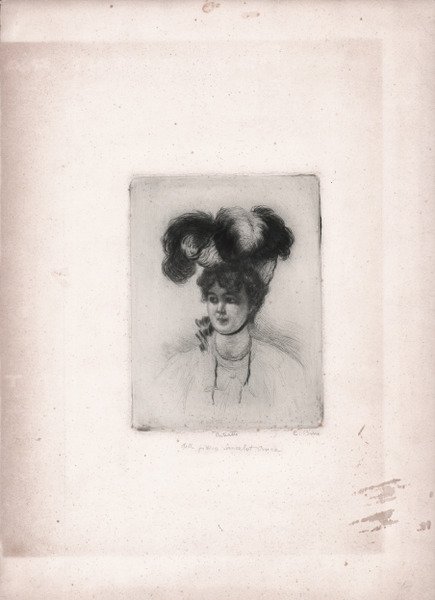Acquaforte e puntasecca, circa 1900. Titolo a matita in basso e firma autografa in basso a destra “C. Biseo”. Magnifica prova, impressa con inchiostro verde su carta coeva, tracce di antica inquadratura, per il resto in eccellente stato di conservazione. Marcelle Renée Lancelot, coniugata Croce (Parigi, 26 gennaio 1854 – ca 1946), è stata una pittrice, scultrice e medaglista francese naturalizzata italiana. In seguito al matrimonio con lo scultore Leonardo Croce, prese la nazionalità italiana, cambiando il nome in Marcella. Visse per diversi anni a Roma, a partire dal 1895. Oltre alla pittura e alla scultura, si dedicò anche fin da giovane alla professione di medaglista. Cesare Biseo pittore, acquarellista e incisore, nasce a Roma, ove il padre, Gian Battista, valente pittore accademico di Brescia, si era da poco trasferito essendo stato chiamato a decorare il castello di Bracciano. Riceve dunque dal padre i primi insegnamenti artistici e, a seguito del genitore, trascorre da giovane un lungo periodo a Parigi. Nel 1869, in occasione dell’inaugurazione del Canale di Suez, il Kedivé d’Egitto lo chiama a decorare prima il suo palazzo in Alessandria e poi il Teatro dell’Opera al Cairo. ' ' Innamoratosi dell’Africa la visita più volte e nel 1875 con Edmondo De Amicis e il pittore Stefano Ussi fa parte della prima missione italiana in Marocco. Ne trae diversi albi di schizzi, che utilizza per illustrare, insieme ad Ussi, il libro di De Amicis, Marocco, edito nel 1877 dalla casa editrice Treves di Milano. Nello stesso anno accompagna De Amicis a Costantinopoli, illustrando poi l’omonimo libro dello scrittore pubblicato nel ’78 sempre dalla Treves. Il grande successo di entrambe le edizioni consacra Biseo “orientalista”, spingendolo ad intensificare la produzione di oli ed acquarelli a soggetto arabo. Intanto nel 1875, assieme a E. Roesler Franz e N. Cipriani, fonda a Roma la Società degli Acquerellisti, di cui diviene presidente nel 1881. La vena orientalista, infatti, non gli aveva fatto dimenticare la passione per i paesaggi della Campagna Romana, ritratti con grande fedeltà ed originali tagli di luce (“l’ardito effetto di sole”), evolvendo dall’originario gusto classico verso soluzioni sempre più veriste. Lo troviamo anche tra i soci fondatori del Gruppo dei XXV della Campagna romana, ove Pascarella gli affibbia il nomignolo di “cariate” per i suoi trascorsi egiziani. Ebbe lo studio a via Margutta e fu, come le foto di Oreste Sgambati stanno a dimostrare, un frequentatore assiduo del Caffè Greco, dove fu soprannominato “professorissimo” per la sua maestria a biliardo. Oltre agli affreschi ed alle decorazioni degli esordi, dipinge ugualmente bene ad olio e all’acquarello. Si è inoltre dedicato con successo all’acquaforte, come dimostrano le sue bellissime illustrazioni di libri. Il presente ritratto di Marcella Lancelot Croce, confrontando le biografie dei due artisti, risale al periodo tra il 1895 e il 1909, tra l'arrivo della pittrice a Roma e la scomparsa di Biseo. Opera non descritta da nessuno dei repertori consultati. Molto rara. Etching and drypoint, circa 1900. Title in pencil at bottom and autograph signature at bottom right "C. Biseo". ' Magnificent example, impressed in green ink on coeval paper, traces of old framing, otherwise in excellent condition. Marcelle Renée Lancelot (Paris, January 26, 1854 - ca 1946) was a French painter, sculptor and medallist naturalized Italian. Following her marriage to the sculptor Leonardo Croce, she took Italian nationality, changing her name to Marcella. She lived for several years in Rome, starting in 1895. In addition to painting and sculpture, she devoted herself to the profession of medallist since she was young. ' The present portrait of Marcella Lancelot Croce, comparing the biographies of the two artists, dates from the period between 1895 and 1909, between the painter's arrival in Rome and Biseo's death. Work not described by any of the repertories consulted. Very rare. Cesare Biseo painter, watercolorist and engraver, was born in Rome, where his father, Gian Battista, a talented academic painter from Brescia, had recently moved to decorate the castle of Bracciano. Receives therefore from the father the first artistic teachings and, following the parent, spends as a young man a long period in Paris. In 1869, on the occasion of the inauguration of the Suez Canal, the Kedivé of Egypt called him to decorate first his palace in Alexandria and then the Opera House in Cairo. ' ' Having fallen in love with Africa, he visited it several times and in 1875 with Edmondo De Amicis and the painter Stefano Ussi was part of the first Italian mission to Morocco. It draws several albums of sketches, which used to illustrate, along with Ussi, the book of De Amicis, Morocco, published in 1877 by the publisher Treves in Milan. In the same year accompanies De Amicis in Constantinople, then illustrating the homonymous book of the writer published in '78 always by Treves. The great success of both editions consecrates Biseo "orientalist", pushing him to intensify the production of oils and watercolors to Arab subject. Meanwhile in 1875, along with E. Roesler Franz and N. Cipriani, founded in Rome the Society of Watercolorists, of which he became president in 1881. The orientalist vein, in fact, had not made him forget the passion for the landscapes of the Roman countryside, portrayed with great fidelity and original cuts of light ("the bold effect of the sun"), evolving from the original classical taste towards more and more realistic solutions. We also find him among the founding members of the Group of XXV of the Roman Countryside, where Pascarella gives him the nickname of "cariate" for his Egyptian past. He had a studio in Via Margutta and was, as the photos of Oreste Sgambati demonstrate, a frequent visitor to the Caffè Greco, where he was nicknamed "professorissimo" for his mastery at billiards. In addition to the frescoes and decorations of the early days, he painted equally well in oil and watercolor. He also devoted himself successfully to etching, as evidenced by his beautiful book illustrations. Cfr.


Descubre cómo utilizar
Descubre cómo utilizar

